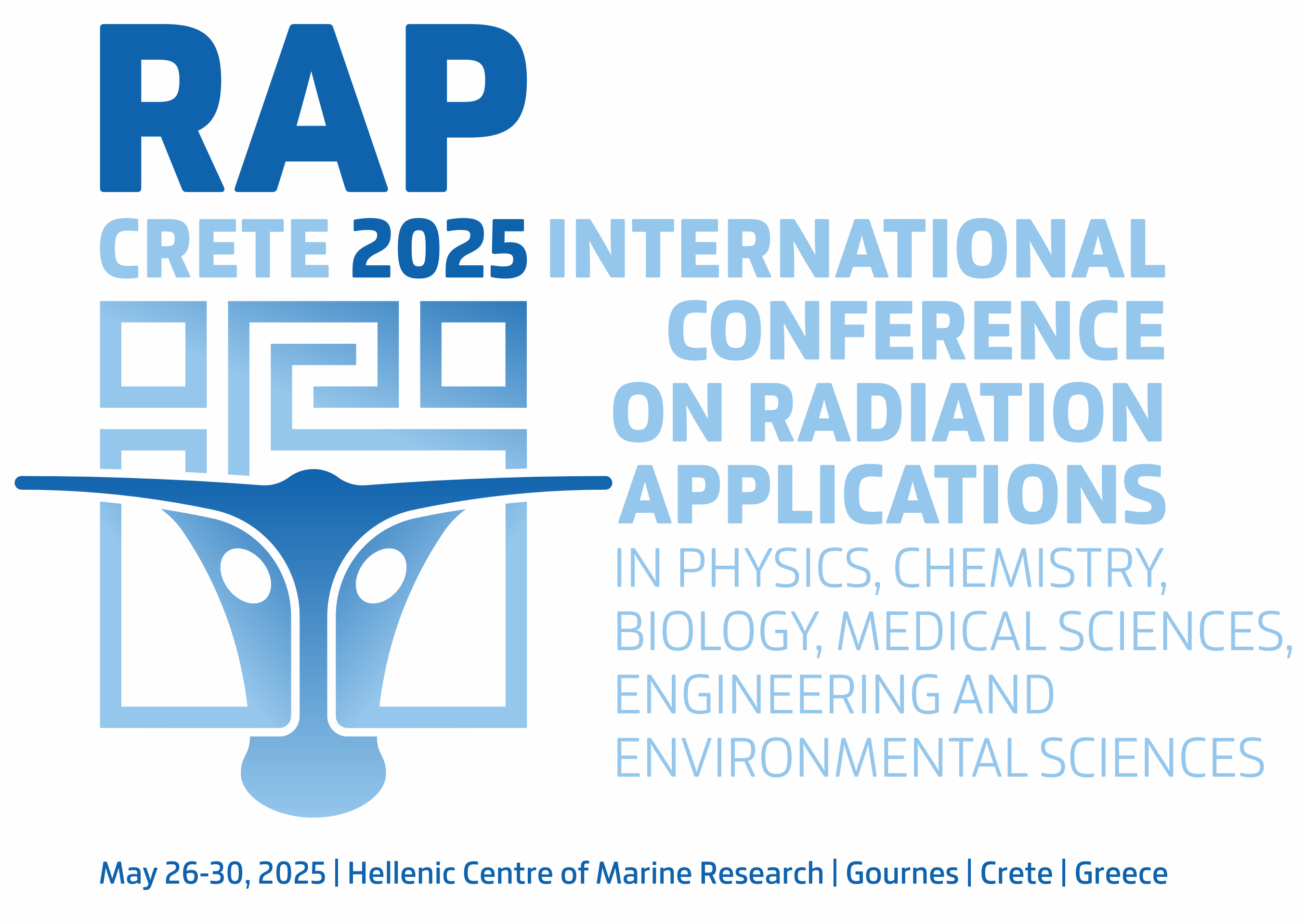Vol. 4, 2019
Radiation Effects
IRRADIATION EFFECT ON Er2O3/n-Si STRUCTURE UNDER HIGH GAMMA-RAY DOSE
Aysegul Kahraman, Berk Morkoc, Alex Mutale, Umutcan Gurer, Ercan Yilmaz
Pages: 152–155
DOI: 10.37392/RapProc.2019.31
Abstract | References | Full Text (PDF)
The aim of this study is to investigate the structural transformations of erbium oxide (Er2O3) dielectric which can be used as a sensitive region in the new generation RadFET radiation sensors under a high gamma dose. The Er2O3 film was grown on n-type Si (100) by RF magnetron sputtering and film thickness was measured as 118 nm. The samples were irradiated by a 60Co radioactive source with the doses of 1 kGy, 25 kGy, and 50 kGy. The crystal structure samples were analysed by the X-ray diffraction method. The variation in the bond properties of the as-deposited Er2O3 film was investigated by X-ray photoelectron spectroscopy. The pre-irradiation Er2O3 film demonstrated an amorphous structure, and the peaks belonging to the cubic phase were observed after irradiation, their density increasing with increasing the dose. The Er 4d spectra of the Er2O3/Si films were two fitted peaks indicating Er-Er and Er-O bonds, except for the interface. The binding energy shifted to higher energies with increasing the depth from due to possible ErSiOx formation at the interface. The Si-O/Er-O and M/O ratios change with the applied dose and film depth.
- J. O. Goldsten et al., “The Engineering Radiation Monitor for the Radiation Belt Storm Probes Mission,” Space Sci. Rev., vol. 179, no. 1 – 4, pp. 485 – 502, Nov. 2013.
DOI: 10.1007/s11214-012-9917-x - M. M. Pejovic, M. M. Pejovic, A. B. Jaksic, “Contribution of fixed oxide traps to sensitivity of pMOS dosimeters during gamma ray irradiation and annealing at room and elevated temperature,” Sens. Actuator A-Phys., vol. 174, no. 1, pp. 85 – 90, Feb. 2012.
DOI: 10.1016/j.sna.2011.12.011 - E. Yilmaz et al., “Investigation of RadFET response to X-ray and electron beams,” Appl. Radiat. Isot., vol. 127, pp. 156 – 160, Sep. 2017.
DOI: 10.1016/j.apradiso.2017.06.004
PMid: 28622597 - S. J. Rhee, J. C. Lee, “Threshold voltage instability characteristics of HfO2 dielectrics n-MOSFETs,” Microelectron. Reliab., vol. 45, no. 7 – 8, pp. 1051 – 1060, Jul.-Aug. 2005.
DOI: 10.1016/j.microrel.2005.01.006 - G. Thriveni, K. Ghosh, “Performance analysis of nanoscale double gate strained silicon MOSFET with high k dielectric layers,” Mater. Res. Express, vol. 6, no. 8, May 2019.
DOI: 10.1088/2053-1591/ab1fca - A. Kahraman, E. Yilmaz, “Proposal of alternative sensitive region for MOS based radiation sensors: Yb2O3,” J. Vac. Sci. Technol., vol. 35, no. 6, p. 061511, Nov. 2017.
DOI: 10.1116/1.4993545 - A. Kahraman, E. Yilmaz, A. Aktag, S. Kaya, “Evaluation of Radiation Sensor Aspects of Er2O3 MOS Capacitors under Zero Gate Bias,” IEEE Trans. Nucl. Sci., vol. 63, no. 2, pp. 1284 – 1293, Apr. 2016.
DOI: 10.1109/TNS.2016.2524625 - E. Yilmaz, B. Kaleli, R. Turan, “A systematic study on MOS type radiation sensors,” Nucl. Instrum. Methods Phys. Res., vol. 264, no. 2, pp. 287 – 292, Nov. 2007.
DOI: 10.1016/j.nimb.2007.08.081 - E. Yilmaz, S. Kaya, “A Detailed Study on Zero-Bias Irradiation Responses of La2O3 MOS Capacitors,” IEEE Trans. Nucl. Sci., vol. 63, no. 2, pp. 1301 – 1305, Apr. 2016.
DOI: 10.1109/TNS.2016.2530782 - J. I. Langford, A. J. C. Wilson, “Scherrer after sixty years: A survey and some new results in the determination of crystallite size,” J. Appl. Crystallogr., vol. 11, pp. 102 – 113, Apr. 1978.
DOI: 10.1107/S0021889878012844 - S. Gokhale et al., “Photoemission and x-ray diffraction study of the ErSi(111) interface,” Surf. Sci., vol. 237, no. 1 – 3, pp. 127 – 134, Nov. 1990.
DOI: 10.1016/0039-6028(90)90525-D - R. Xu, Q. Tao, Y. Yang, C. G. Takoudis, “Atomic layer deposition and characterization of stoichiometric erbium oxide thin dielectrics on Si(100) using (CpMe)3Er precursor and ozone,” Appl. Surf. Sci., vol. 258, no. 22, pp. 8514 – 8520, Sep. 2012.
DOI: 10.1016/j.apsusc.2012.05.019 - J. Zhang, H. Wong, D. Yu, K. Kakushima, H. Iwai, “X-ray photoelectron spectroscopy study of high-k CeO2/La2O3 stacked dielectrics,” AIP Adv., vol. 4, no. 11, Nov. 2014.
DOI: 10.1063/1.4902017 - Z. Guo et al., “Solution-processed ytterbium oxide dielectrics for low-voltage thin-film transistors and inverters,” Ceram. Int., vol. 43, no. 17, pp. 15194 – 15200, Dec. 2017.
DOI: 10.1016/j.ceramint.2017.08.052 - C. H. Kao, H. Chen, Y. T. Pan, J. S. Chiu, T. C. Lu, “The characteristics of the high-K Er2O3 (erbium oxide) dielectrics deposited on polycrystalline silicon,” Solid State Commun., vol. 152, no. 6, pp. 504 – 508, Mar. 2012.
DOI: 10.1016/J.SSC.2011.12.042 - G. S. Ristić, M. M. Pejović, A. B. Jakšić, “Physico-chemical processes in metal–oxide–semiconductor transistors with thick gate oxide during high electric field stress,” J. Non.-Cryst. Solids, vol. 353, no. 2, pp. 170 – 179, Feb. 2007.
DOI: 10.1016/J.JNONCRYSOL.2006.09.020


